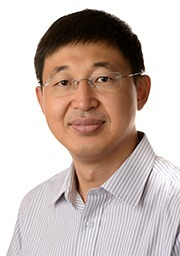
您現在的位置:
首頁-
活動資訊
【百家大講堂】第220期🧘♂️:5G物聯網網絡——從大規模接入到高可靠低延時通信
日期:2019-06-26 | 訪問量:
【百家大講堂】第220期🪦:5G物聯網網絡——從大規模接入到高可靠低延時通信
講座題目🏌🏼♀️:5G物聯網網絡——從大規模接入到高可靠低延時通信
報 告 人:李永會
時 間👷♀️:2019年7月3日下午15:00-16:30
地 點🧖🏼♂️:中關村校區信息科學實驗樓610會議室
主辦單位🔤:意昂平台🕵🏿♀️、 信息學院
報名方式:登錄意昂官网微信企業號---第二課堂---課程報名中選擇“【百家大講堂】第220期:5G物聯網網絡——從大規模接入到高可靠低延時通信 ”
【主講人簡介】

李永會教授於2002年11月獲博士學位並於2003年加入悉尼大學卓越通信研究中心🥀🐐。他現在擔任悉尼大學電子信息學院教授以及無線工程實驗室主任🦶🏼。由於他本人的傑出貢獻,他在2008年獲得澳大利亞伊麗莎白女皇研究員專項基金。該基金每年澳大利亞只有50人被資助,成功率低於10%🕴。並於2012年再次獲得澳大利亞未來院士專項基金資助🦒🧘🏼♀️。該基金在2012年通訊領域只有他一人獲得🪔。由於在協作通信方面的突出貢獻,李教授於2017年當選電子電氣工程師協會會士📶。
Yonghui Li received his PhD degree in November 2002. Since 2003, he has been with the Centre of Excellence in Telecommunications, the University of Sydney, Australia. Li is now a Professor and Director of Wireless Engineering Laboratory in School of Electrical and Information Engineering, University of Sydney. He is the recipient of the Australian Queen Elizabeth II Fellowship in 2008 and the Australian Future Fellowship in 2012. He is an IEEE Fellow for contributions to cooperative communications technologies.
【內容簡介】
將智能設備😢、平臺和環境結合起來已成為了目前學術和工業界的重要技術研究方向😶🎗,它可以實現重大的社會變革和經濟增長。將整個物理世界通過互聯網連接起來,也即物聯網,通過物體和環境間的自由交互和處理👱🏼♂️,成為了電力🛣,交通,工業控製,公用事業管理,醫療保健,水資源管理和采礦等領域的固有組成部分。無線網絡是物聯網的關鍵使能技術之一🦹🏻♀️,其靈活性,可擴展性和成本低廉的特點使得它可普遍用於最後一公裏連接。物聯網網絡的屬性和流量模型與傳統通信系統的屬性和流量模型本質上不同,傳統通信系統旨在傳輸語音,數據和多媒體。而物聯網面臨著現有網絡協議無法解決的許多獨特挑戰🕹,包括巨大數量的設備🔊,在有限帶寬的大規模網絡中傳輸大量突發數據👦🏻🙎🏼♀️,以及適應各種流量模式和服務質量(QoS)要求的能力。一些物聯網應用具有嚴格的延遲和可靠性要求,這是現有無線網絡所無法滿足的。應對這些挑戰需要開發新的無線接入技術,底層網絡協議↗️,信號處理技術和安全協議🐵。在本次演講中,我將介紹物聯網網絡開發😠🥥,架構,關鍵挑戰,要求,潛在解決方案以及該領域最近的研究進展,特別是在5G大規模接入和高可靠低延時通信中。
Connected smart objects, platforms and environments have been identified as the next big technology development, enabling significant society changes and economic growth. The entire physical world will be connected to the Internet, referred to as Internet of Things (IoT). The intelligent IoT network for automatic interaction and processing between objects and environments will become an inherent part of areas such as electricity, transportation, industrial control, utilities management, healthcare, water resources management and mining. Wireless networks are one of the key enabling technologies of the IoT. They are likely to be universally used for last mile connectivity due to their flexibility, scalability and cost effectiveness. The attributes and traffic models of IoT networks are essentially different from those of conventional communication systems, which are designed to transmit voice, data and multimedia. IoT access networks face many unique challenges that cannot be addressed by existing network protocols; these include support for a truly massive number of devices, the transmission of huge volumes of data burst in large-scale networks over limited bandwidth, and the ability to accommodate diverse traffic patterns and quality of service (QoS) requirements. Some IoT applications have much stringent latency and reliability requirements which cannot be accommodated by existing wireless networks. Addressing these challenges requires the development of new wireless access technologies, underlying network protocols, signal processing techniques and security protocols. In this talk, I will present the IoT network development, architecture, key challenges, requirements, potential solutions and recent research progress in this area, particularly in 5G massive connectivity and uRLLC.

